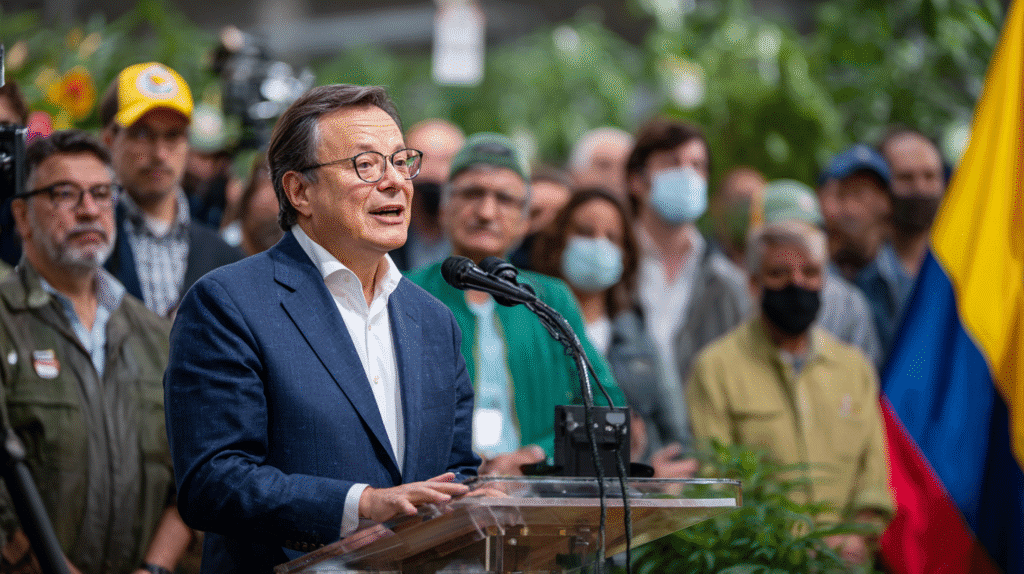Colombia’s Bold Cannabis Diplomacy Challenges U.S. Drug Policy

As tensions between the U.S. military and Colombia heightened over alleged drug interdiction operations, Colombian President Gustavo Petro chose a rather unexpected course of action in a move that took place on October 28, 2025.
Instead of continuing to release diplomatic protests over U.S. military attacks on alleged Colombian drug-laden vessels, Petro called upon U.S. President Donald Trump to “legalize the export of cannabis.”
A farmer in Colombia’s Cauca region, Carlos Martinez, is one of the many agricultural laborers who turned from growing marijuana illicitly to legally growing the drug since the year 2016. “We want to be businessmen, not felons,”
Martinez stated. “President Petro is a fighter in defense of farmers such as myself who choose marijuana over coca.” Today, legal marijuana in Colombia is worth hundreds of millions of dollars.
This is a reflection of a pressing international issue that tackles a wider disappointment in U.S. double standards in drug issues. This is a situation where a significant number of states in the U.S. allow the use of cannabis, yet American businesses are not able to import medical marijuana from Colombia due to U.S. laws.
Avicanna has developed a comprehensive worldwide network and is making Colombia a worldwide leader in medical cannabis production.
“Cannabis needs to be treated the same way as any product,” Petro stated, sparking a challenge to American prohibition out of a dispute over security. This is a radical move towards economic partnership strategies as opposed to conflict-driven drug strategies, offering new hope in treatment access as well as stronger U.S. – Latin American relations.
Source: marijuanamoment.net
Morocco’s Medical Cannabis Breakthrough Reaches Africa

Fatima Al-Zahra’s hands were shaking as she grasped a small bottle of cannabis oil on October 17, 2025.
This is important because Al-Zahra is a 34-year-old epilepsy sufferer in Cape Town who had just become the first person outside of Morocco to use the new cannabis drug developed in her region, which is a milestone in African collaboration.
Al-Zahra is a school teacher who had been having seizures that had been affecting her duties.
This historic export of medical cannabis products came as a result of collaboration between the Moroccan laboratory CANNAFLEX and the South African pharmaceutical company DRA Pharmaceuticals.
“This collaboration is a game-changer in medical cannabis as it makes available to patients safe, reliable, and evidence-based treatment options,” stated DRA Pharmaceuticals’ CEO, Chris Hutton.
Morocco’s transition from a clandestine hashish manufacturer to a pharmaceutical giant began in 2021 with the legalization of medical cannabis. It utilized agricultural acumen and climate diversity to breed a local variety of pharmaceutical-grade cannabis known as Beldiya, which had been inspired by the age-old practice of growing cannabis in regions such as Chefchaouen.
This export comes after Morocco conducted its first locally produced medical cannabis product export in December of last year, with pharmaceutical company Pharma 5 launching “Cannabidiol Pharma 5” in response to a $27.1 million investment targeting drug-resistant epilepsy.
Market analysts forecast that the medical cannabis industry is expected to grow to a total of $21.4 billion in the year 2025, as African nations see a favorable opportunity in medical cannabis due to lower costs of production.
Source: ecofinagency.com
Cannabis Beats Placebo in Historic Migraine Study

Jessica Chen had already tried every possible treatment for her migraines— dozens of drugs, Botox injections, a nerve stimulator implanted in her head—and none of them had given her any sustained relief until she enrolled in the first-ever placebo-controlled trials of cannabis as a treatment for acute migraines at UC San Diego.
The findings of this pioneering study are the first convincing evidence that cannabis is a genuinely effective treatment for migraines, a problem that afflicts some 39 million Americans.
This rigorous trial involved a group of 92 patients who experienced a total of 247 migraines treated with one of four vaporized therapies that included either 6% THC, 11% CBD, a combination of THS-CBD, or a placebo that contained cannabis flowers.
“The combination of THS-CBD produced a response rate of pain relief of 67.2% of participants vs. 46.6% with placebo, with a lasting response of between 24 to 48 hours,”
explained Dr. Nathaniel Schuster, a pain neurologist.
For Jessica, who had been living with migraines for over 15 years, the findings offer hope.
“The combination of cannabis components is the first thing that has effectively halted my migraines without leaving me feeling worse,” Jessica stated.
To address long-held issues of research bias, the same vaporization capsules were given to participants in the experiment, who were also informed of “cannabis placebo high.”
Though the cannabis flowers used in the study had lower levels of THC than what is found in recreational use, experts point out that higher doses are not always effective.
This is important, especially considering that cannabis is already in use as a form of treatment by 31% of those under care for chronic pain.
Source: pmc.ncbi.nlm.nih.gov
Mexico’s $1.2 Billion Cannabis Revolution

A Mexican economist named Dr. Elena Rodriguez never could have expected that her phenomenal findings indicating a taxation gain of $1.2 billion a year through cannabis legalization would spur elected officials in the second-largest Latin American economy to move towards the legalization of cannabis.
Dr. Rodriquez’s findings, based upon a user base of 1.4 million people in the nation, are unprecedented in that they are giving a boost to the legalization of cannabis in Mexico.
A representative of the millions of people who could benefit from full legalization is Carlos Mendoza, a resident of Mexico City with a condition that is treated with high-cost medical cannabis. “Medical cannabis is expensive as well as difficult to access,” Mendoza stated. “Full legalization will certainly result in a radical change in this scenario.”
Medical marijuana is legal in Mexico since 2017, and recreational marijuana is legal in theory as of 2021. Although the nation’s Supreme Court struck down medical cannabis prohibition as unconstitutional, there is a lack of commercial legislation in place. A total of six licenses will be issued: those involving vertical integration, production, distribution, retailing, extraction, as well as research.
“The numbers are enticing precisely because they represent a genuine source of consumer demand that is presently met by illicit sources,” Rodriguez added.
“Legalization could harvest that money for public purposes as well as generate legal employment opportunity as a consequence of reduced enforcement costs.”
Regional cannabis businesses are aware of the fact that a legal Mexican environment could generate a trans-national industry that could range from Canadian to Colombian shores, with Mexico as a central hub.
Source: cannabusinessplans.com
2025 Cannabis Research Reaches Scientific Critical Mass

Dr. Maria Santos can attest to a time when conducting medical cannabis studies was nearly impossible—there simply wasn’t any point in doing so, as it was “career suicide.”
Today, Dr. Santos is involved in one of more than 160 peer-reviewed studies that were published in the first half of 2025 alone, denoting what is termed a “turning point” in the field of cannabis studies. Dr. Santos’ cancer studies demonstrate positive correlations between cannabis use and cancer symptom management.
This research explosion is a reflection of a paradigm shift in scientific values and attitudes as well as public policy. A time when federal regulations prohibited any form of cannabis-based research is today giving way to a new era of openness to science, in response to increased calls from patients.
This is where businesses such as Elevate Holistics are capitalizing on this explosion of new research under the leadership of Aspen Noonan, who is the CEO of the firm.
“What we’re seeing from the 2025 studies is a turning point,” continues Noonan. “The science is starting to catch up to what patients have been telling us for years: that when medical cannabis is properly administered under physician oversight, it can meanfully improve lives.”
This wave of scientific inquiry is not bound in a university setting, as telemedicine platforms, medical clinics, and pharma businesses are funding studies that span from lab discoveries to practical experiences.
For a scientist such as Dr. Santos, the year 2025 is a sign of vindication after years of battling to promote cannabis research.
What the over 160 studies cover is certainly a broad range of the benefits that cannabinoids exert in various neurological disorders, in various states of the body involving the abnormal expression of the immune system, in various cases of sleep disorders, as well as in excessive inflammation in the body.
Source: prnewswire.com


